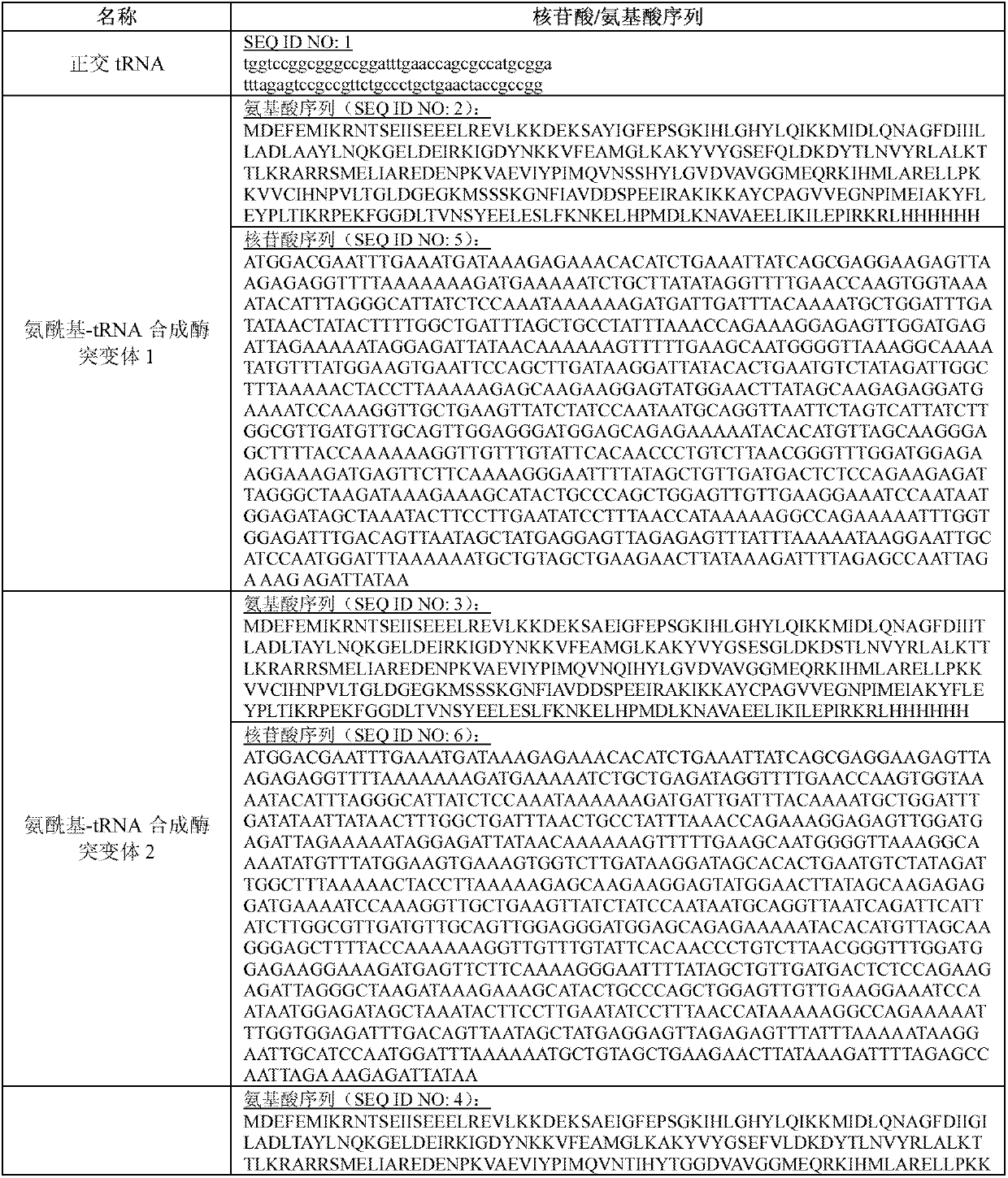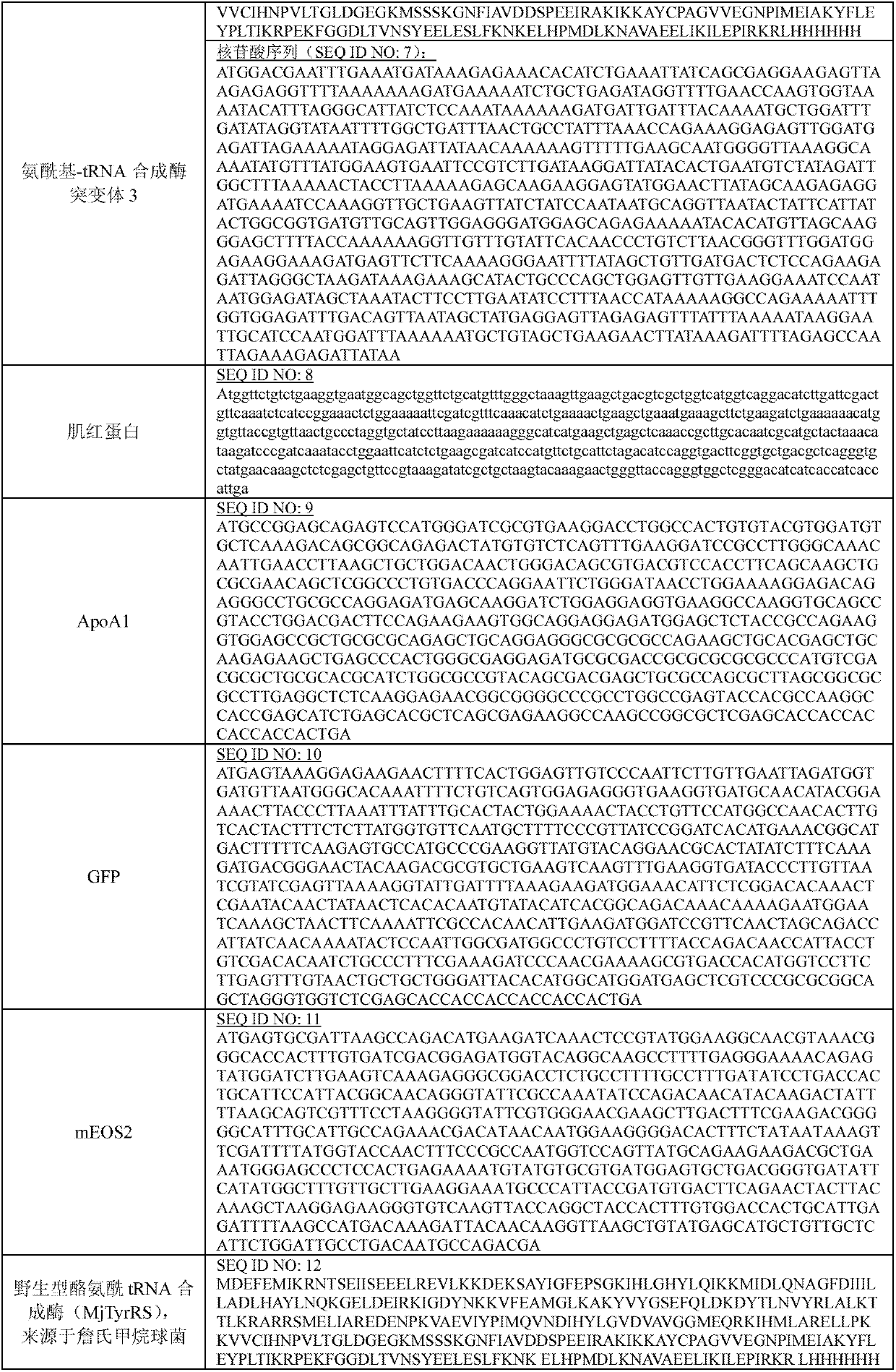3-chlorinated tyrosine translation system and application thereof
A technology of chlorotyrosine and translation system, applied in the direction of application, use of vectors to introduce foreign genetic material, biochemical equipment and methods, etc., can solve problems such as not suitable for labeling lysosomes
- Summary
- Abstract
- Description
- Claims
- Application Information
AI Technical Summary
Problems solved by technology
Method used
Image
Examples
Embodiment 1
[0053] Example 1: Evolution of 3-Cl-Tyr-specific aminoacyl-tRNA synthetases
[0054] In order to site-specifically insert 3-Cl-Tyr into the gene, it is necessary to introduce an aminoacyl-tRNA synthetase / tRNA orthogonal pair into the E.coli host cell used, which is derived from Methanococcus jannaschii jannaschii) Amber suppresses tyrosyl tRNA (MjtRNA CUA Tyr ) / tyrosyl tRNA synthetase (MjTyrRS, wild type, its amino acid sequence is SEQ ID NO: 12) pair. The MjTyrRS mutation library was constructed in the kanamycin-resistant pBK plasmid (purchased from the laboratory of Peter G. Schultz, Scripps Research Institute, USA), and located between the promoter and terminator of E. coli glutamine synthetase on the plasmid. The synthetic enzyme mutation library used is the pBk-lib-jw1 library, and the construction method of the mutation library is: select 6 sites (Tyr32, Leu65, Phe108, Gln109, Asp158, and Leu162) on the MjTyrRS gene and introduce NNK mutation ( N=A+T+C+G; K=T+G), the ...
Embodiment 2
[0058] Example 2: Expression of 3-Cl-Tyr-myoglobin and identification by mass spectrometry
[0059] The orthogonal tRNA (SEQ ID NO: 1) and the screened aminoacyl-tRNA synthetase mutant 1 (SEQ ID NO: 5) were respectively constructed into the pEVOL vector (purchased from the laboratory of Peter G. Schultz, Scripps Research Institute, USA) Then co-transformed into pbad-myoglobin (4TAG) containing pbad-myoglobin (4TAG) (this plasmid was purchased from the laboratory of Peter G.Schultz of the American Scripps Research Institute) (wherein the nucleotide sequence of myoglobin (4TAG) is SEQ ID NO: 8) DH10B cells (purchased from Quanshijin Company). Pick a single clone and grow to OD at 37°C 600 When it was approximately equal to 0.5, 1 mM 3-Cl-Tyr (purchased from Shanghai Jier Biochemical Company) and 0.2% arabinose (purchased from sigma Company) were added to the LB medium to culture the cells, and the control did not add 3-Cl-Tyr. After 6-8 hours, the bacteria were harvested, and ...
Embodiment 3
[0061] Example 3: Expression of ApoA1 inserted with 3-Cl-Tyr and its identification by mass spectrometry
[0062] AopA1 (nucleotide sequence is SEQ ID NO: 9) was constructed on the pet24a vector (purchased from Novagen), and orthogonal tRNA (SEQ ID NO: 1) and the screened aminoacyl-tRNA synthetase mutant 1 (SEQ ID NO: 5) were respectively constructed on the pEVOL vector (purchased from the laboratory of Peter G. Schultz, Scripps Research Institute, USA). TAG was introduced at position 192 of ApoA1 by overlapping PCR method. Co-transform pEVOL-tRNA, pEVOL-3-Cl-TyrRS and pet24a-ApoA1-192TAG into BL21(DE3) cells (purchased from Quanshijin Company), and pick a single clone into 2YT medium (each liter medium contains 16g pancreatic Peptone, 5g yeast powder, 5gNaCl), plus corresponding antibiotics (kanamycin 50ug / ml tetracycline 10ug / ml). When cells grow to OD 600When it is about 1.0, add 1 mM 3-Cl-Tyr, 0.5 mM IPTG, 0.2% arabinose, and continue culturing at 37°C for 6-8 hours. H...
PUM
 Login to View More
Login to View More Abstract
Description
Claims
Application Information
 Login to View More
Login to View More - R&D
- Intellectual Property
- Life Sciences
- Materials
- Tech Scout
- Unparalleled Data Quality
- Higher Quality Content
- 60% Fewer Hallucinations
Browse by: Latest US Patents, China's latest patents, Technical Efficacy Thesaurus, Application Domain, Technology Topic, Popular Technical Reports.
© 2025 PatSnap. All rights reserved.Legal|Privacy policy|Modern Slavery Act Transparency Statement|Sitemap|About US| Contact US: help@patsnap.com



